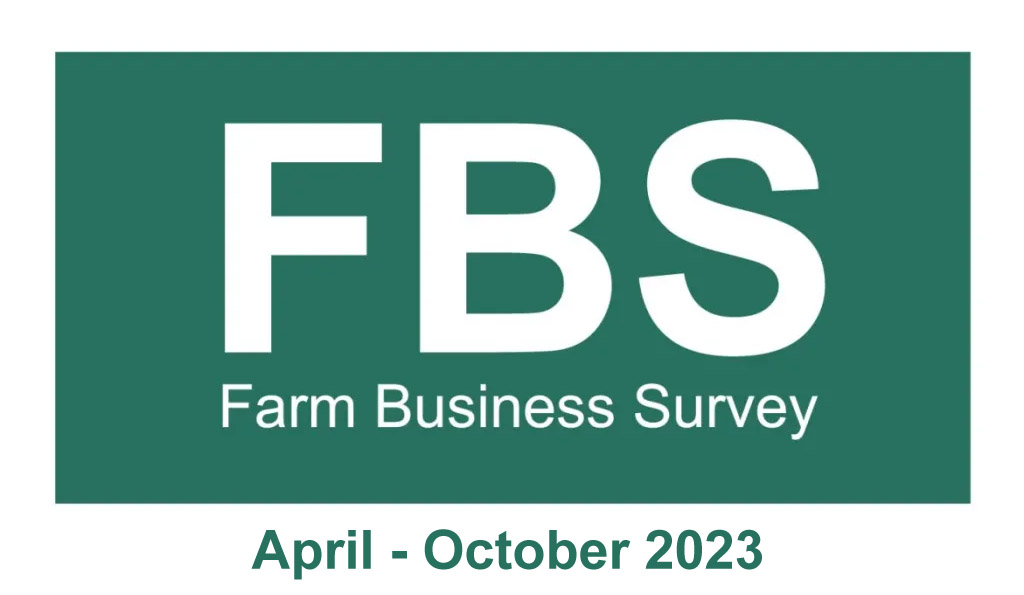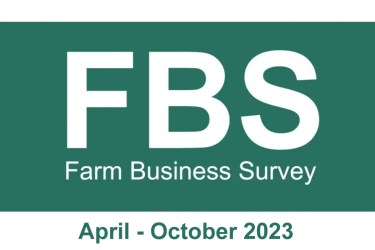Here we present a quick roundup of the latest interviews and conversations with farmers, undertaken by research officers working on the Farm Business Survey. The full report is available at the bottom of this summary. You can sign up to become part of the Farm Business Survey by clicking the buttons shown on this page.
April-October 2023 results
We collected this information over a six-month period, from the beginning of April 2023 through to the end of October 2023.
In general, farmers see volatility and living with risk as the norm.
Forage harvest
As farms enter the winter period forage stocks are high. However, changeable weather conditions resulted varying quality of forage, and less hay.
Milk
UK milk prices have fallen by over 25%, from a high of 51ppl early in 2023, to an average of 37ppl in September. High feed, energy and fertiliser costs combined with a lack of skilled labour are concerning dairy farmers with many businesses now receiving less than the cost of production.
Beef
Market prices have stabilised, but input prices remain high, putting pressure on margins. New Bovine TB (bTB) rules come into force in December 2023. These will require post-movement testing for cattle purchased from high-risk bTB areas, which will squeeze cattle producers’ margins further.
Sheep
Lambing 2023 – the dry summer of 2022 lowered conception rates. The withdrawal of certain vaccines and a cold, wet spring negatively affected lamb health and increased their mortality levels. As a result, with fewer lambs compared to 2022, lamb prices have been strong.
Store lamb sales in the northern regions achieved prices higher than the previous year due to the stronger fat trade, fewer lambs and good forage availability. In the West Midlands fat lambs are cheaper than store.
The annual Hawes gimmer lamb sale reported prices of £4/head higher than the previous year. Shearling prices in the North and Midlands have also been strong, as much as £20-30/head more expensive than in 2022.
However, high input costs and low prices for wool mean that margins remain under pressure.
Pigs
Producers continue to leave the sector due to costs of inputs and returns that, although higher, do not cover costs. This is generally due to the heavy capital investment required, high feed prices and energy prices, and elevated costs of borrowing.
Due to farmers exiting the sector, breeding sows are being sold as cull.
Finished pig prices increased by around 25% during the period, from £130 to £160/head. However, fat pig prices fell in the autumn, to 216p/kg deadweight. Pig feed began to fall too, which will help offset the reduction.
Poultry
Like the pig sector, poultry has been affected by raised input costs and low returns – but has the added challenge of avian flu. Capital costs, high feed and energy prices, and raised lending rates, have further attacked margins.
Outbreaks of avian flu have been reported across the regions. The residual effect on producers is lengthy, due to the need for 12-month quarantines for affected sites. Avian-flu insurance premiums are reported as being unaffordable.
Many free-range producers are reducing flocks or ceasing production, which has led to egg shortages. The free-range egg price increased towards the end of the period with some receiving £1.47/dozen. Whilst welcomed, it may not be enough for some producers to return a profit.
Cultivations
The relatively wet summer resulted in lodged crops which impeded combines and resulted in losses, poor quality grain, high moisture levels increasing crop drying costs and less straw was baled in sharp contrast to the exceptional dry harvest of 2022.
The dry and warm early October weather aided cultivations and drilling, but this was short lived. The rain later in October, plus autumn storms, added to the already saturated ground, impeded drilling of later crops and hampered harvests, including maize and sugar beet.
The extended dry period after spring planting impacted on the development of the late drilled spring crops.
Crop prices are reported as insufficient relative to input costs, notably the high fertiliser and sprays costs. There has been a move to using Liquid Nitrogen, due to it being cheaper and allows for more targeted foliar application.
- Vineyards – very good yields with exceptionally high sugar contents in the grapes. There is increasing mechanisation in this sector, which appears to have the financial backing and capability to adopt new tools to enable a reduction in labour requirements.
- Top fruits – good yields following optimal weather conditions during the growing season in the Southeast. Some large-scale producers are pulling out of the high intensity fruit growing market, with a move towards downscaling and into a type of regenerative farming approach with reduced outputs and reduced reliance on labour and inputs.
- Cider apples – the season started well. Apples are not large or ripe this year due to weather conditions over the summer. However, they have a reasonable sugar content. Dry picking conditions in September and early October have increased yield due to less wastage and the price is stable, although costs continue to rise.
- Hops – the Worcestershire hop harvest had perfect picking conditions for the best quality crops. However, large stocks remain due to low usage during the Covid period. Forward contracts for hops are limited, which has resulted in a reduction in area of about 40% from pre-Covid times. This puts the hop industry in a precarious position. As the cultivated area becomes smaller, investment in new pesticides, varieties and technology reduces. Aid from Defra in the form of a grant for the breeding programme may be withdrawn.
- Wheat, beans and barley – high yields are reported in the Southeast for wheat, beans, and barley on good quality arable ground.
- Winter oilseed rape (WOSR) – generally established well this autumn, benefiting from good moisture availability in the autumn. However, the soil is very moist below the surface, causing concern about high levels of slug damage. Furthermore, cabbage stem flea beetle has decimated some early sown WOSR crops in the East Midlands. The oil premium is anticipated to be higher due to the current crisis in the Middle East.
- Sugar beet – early yields were disappointing, but the per hectare payments from British Sugar for September crops compensated for this. Crops harvested later have reported reasonable yields in the region of 90t/ha.
Labour – persistent supply problems
In most sectors, problems of attracting and keeping labour is a perennial issue.
The current Seasonal Agricultural Worker Scheme (SAWS) ends in 2024, raising concerns over the lack of a long-term strategy for managing the labour force requirements for the sector.
The exclusion of certain types of workers (eg butchers and poultry dressers) from the Shortage Occupation List (SOL) has caused concern.
Funding schemes
There appears to be increased interest in the Sustainable Farming Incentive schemes (SFIs). However, farmers feel that many schemes are complicated and onerous. SFIs are regarded as targeted to soils and cereals, with limited options available for grazing livestock producers.
Tenants are finding SFIs difficult to access, with areas of land being on short-term agreements. SFI is regarded as targeted to soils and cereals, with limited options available for grazing livestock producers.
Many farmers have either kept the Higher-Level Scheme, or not agreed new schemes due to lack of knowledge and/or direction. They judge the choice overwhelmingly vast and continuously changing.
There appears to be increased enthusiasm amongst farmers not yet in schemes who feel that the SFI may be more suitable for them as it is perceived as being more flexible than Countryside Stewardship Scheme.
Whilst there has been a lot of interest in applying for SFI 2023, there is frustration that it has been delayed alongside a reduction in the Basic Payment Scheme (BPS) which impacts on cash flow.
Farm welfare
Extreme stress levels are reported, with BPS reductions, interest rate rises, labour challenges, legislation increases, volatility, market uncertainty and weather events creating a perfect storm for the industry.
About Farm Business Survey
Defra’s Farm Business Survey (FBS) has been running for over 80 years. It provides data to government to help inform and evaluate policy, using evidence to bring changes that support the industry.
Promar runs FBS on behalf of Defra, as a ringfenced activity away from our commercial ventures. Our mission is to streamline the data collection and processing through a modernisation programme, reducing the burden on participants.
Ultimately, FBS is a project whose sole aim is to help farmers. We welcome the participation of all farms. If you are interested in taking part in FBS then please click this button to sign up.








